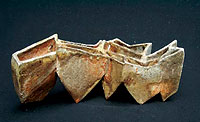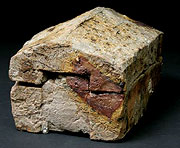
Inside, outside, upside down: Nina Hole’s “Upside Downtown” is a remarkable work about the definitions of shape, surface and the symbolic function of vessels.
|
Western North Carolina, with its rich history of architecture and ceramics, has a unique opportunity to explore the connections between the two forms: The Center for Craft, Creativity & Design in Hendersonville is presenting an outstanding exhibition of works in clay by Danish artist Nina Hole and other ceramicists who use their medium to explore and express ideas about exterior and interior spaces.
Many of the works in the show clearly acknowledge the longstanding connection between building and clay — after all, adobe and mud brick were among the earliest materials used to make shelters.
Nina Hole built — and fired in place — a huge architectural sculpture at Appalachian State using 300 pounds of clay. Hole says that a sense of place is all-important to her, and her large scale works, whether in Greece or Taiwan, relate to their location. Her smaller pieces in the exhibition are thick-walled, angular, and rough-textured. They are very much about inside and outside.

So crude, it’s profound: Tim Rowan’s work “Box” appears to be a rough-hewn showpiece made of stone. In fact, it’s a marvel of symbolism created in clay.
|
Judith Duff, who curated the exhibition, included her own works in the show. She uses clay to refer to ancient ritual and to early astronomical discovery. Bill Griffith takes a direct approach to the idea of shelter: His interest in the houses built by the Anasazi and other indigenous Americans is expressed in forms with openings that reveal their interiors.
Cast shadows are crucial to the works by Jeff Shapiro. His anagama-fired stoneware with natural ash deposits provides a surface he describes as existing in the imperfections of nature. He is an artist who relentlessly seeks to expand our ideas of what we mean when we say that an object is beautiful. Malcolm Wright uses Georgia brick clay for his “In the Corner”. The smooth, slab-constructed form has openings that cast shadows in different directions, bisecting the interior space.
There are large works by Steve Sauer and Al Tennant. Tennant’s impressive “Form #3, Kenia Shrine” is about 3-feet high and features architectural elements holding up a tall, textured form topped by more “posts” capped by a double roof structure. Sauer’s “Keystone” is obvious in its reference, and he accompanies it with a handsome darkly-glazed vase with deeply set chevrons in front.
Joy Brown’s “Currents” is a show stopper! A large wall piece, it is made up of variously sized terra cotta jugs like those found in archeological digs all over the world, except that Brown has given hers slightly more organic shapes. The vessels are arrangned in rows at random angles, their mouths agape like those of anchored sea creatures. Brown is the daughter of missionaries, and lived for 18 years in Japan. She says that her work is a part of the architecture rather than a reference to it.
A deceptively simple box is Tim Rowan’s contribution to the show. It’s a small work with a huge presence. House-shaped, but with a removable top, it’s titled “Box”. The surface and color are so raw and earthy that the piece could have been carved from a piece of stone. The question of use is ambiguous: is it a home, or is it a sarcophagus?
There are no super-shiny glazes in this exhibition. There is no glitz. There is only serious dialogue among artists who use their medium to present their ideas about who we are and how we live.
[Connie Bostic is an Asheville based painter and writer.]
Architectural Echoes in Clay will be on exhibit at the UNC Center for Craft, Creativity & Design (1181 Broyles Road, Hendersonville) through November 10, and a satellite exhibition is being held at the Catherine J. Smith Gallery at Appalachian State University in Boone. Free. 890-2050.



Before you comment
The comments section is here to provide a platform for civil dialogue on the issues we face together as a local community. Xpress is committed to offering this platform for all voices, but when the tone of the discussion gets nasty or strays off topic, we believe many people choose not to participate. Xpress editors are determined to moderate comments to ensure a constructive interchange is maintained. All comments judged not to be in keeping with the spirit of civil discourse will be removed and repeat violators will be banned. See here for our terms of service. Thank you for being part of this effort to promote respectful discussion.